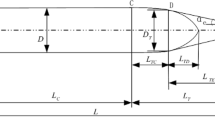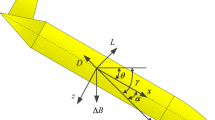Abstract
As ocean resources received considerable attention, the autonomous underwater vehicle (AUV) has been more widely applied due to its excellent flexibility and adaptability, and the optimization design of AUV has becoming a more important issue. The heavier-than-water underwater vehicle (HUV) is a new conceptual AUV, and its design is a typical multidisciplinary problem, but heavily dependent on the experience with naval architects at the present engineering design. To realize the optimization design of HUV, the multidisciplinary design optimization (MDO) method is applied to the multiple objective MDO design of an HUV. In this paper, a system synthesis model of the HUV has been set up. To predict the hydrodynamic characteristics accurately, the computational fluid dynamics (CFD) method is used. In the MDO process, the all-in-one (AIO) method has been adopted with non-dominated sorting genetic algorithms (NSGA)-II and a Kriging model for constructing global approximations to reduce the cost of the CFD numerical simulation. According to the multiple objective MDO design, the Pareto-optimal solutions are analyzed and verified by the numerical simulation, and it is found that the optimal design of HUV has better performance than that of prototype.











Similar content being viewed by others
References
Barry JP, Hashimoto J (2009) Revisiting the challenger deep using the ROV Kaiko. Mar Technol Soc J 43(5):77–78
Wynn Russell B, Huvenne Veerle AI, Le Bas Timothy P et al (2014) Autonomous underwater vehicles (AUVs): their past, present and future contributions to the advancement of marine geoscience. Mar Geol 352:451–468
Li X, Zhao M, Zhao FM, Yuan QQ, Ge T (2014) Study on hydrodynamic performance of heavier-than-water AUV with overlapping grid method. Ocean Syst Eng 4(1):1–19
Wu C, Wang Q, Yan H (2010) Practicability research and design of the underwater plane. In: Proceedings of the ASME 2010 29th International Conference on Ocean, Offshore and Arctic Engineering, OMAE2010-20266, Shanghai, China
Yan H, Ge T, Ying SB, Wu C, Yuan QQ (2012) Analysis of motion in longitudinal plane of negative buoyancy vehicle flying fish II. J Shanghai Jiao Tong Univ (Sci) 17(1):20–24
Sobieszczanski-Sobieski J (1989) Multidisciplinary optimization for engineering systems: achievements and potential. Springer, Berlin Heidelberg
Malone B, Mason WH (1995) Multidisciplinary optimization in aircraft design using analytic technology models. J Aircr 32(2):431–438
Peri D, Campana EF (2003) Multidisciplinary design optimization of a naval surface combatant. J Ship Res 47(1):1–12
Martz M, Neu WL (2009) Multi-objective optimization of an autonomous underwater vehicle. Mar Technol Soc J 43(2):48–60
McAllister CD, Simpson TW, Kurtz PH, Yukish M (2002) Multidisciplinary design optimization testbed based on autonomous under water vehicle design. In: Proceedings of 9th AIAA/ISSMO Symposium on Multidisciplinary Analysis and Optimization, Atlanta, Georgia, USA
Cramer EJ, Dennis JE, Frank PD, Lewis RM, Shubin GR (1994) Problem formulation for multidisciplinary optimization. SIAM J 4(4):754–776
Zhao M, Cui WC, Ge T (2015) Multidisciplinary design optimization of a heavier-than-water underwater vehicle using a semi-empirical model. Submitted to Ocean Engineering
Simpson TW, Booker AJ, Ghosh D, Giunta AA, Koch PN, Yang RJ (2004) Approximation methods in multidisciplinary analysis and optimization: a panel discussion. Struct Multidiscip Optim 27(5):302–313
Jin Y (2005) A comprehensive survey of fitness approximation in evolutionary computation. Soft Comput 9(1):3–12
Simpson TW, Mauery TM, Korte JJ, Mistree F (2001) Kriging models for global approximation in simulation-based multidisciplinary design optimization. AIAA J 39(12):2233–2241
Yan H (2012) Investigation on design, navigation and motion performance of a heavier-than-water AUV. Ph.D Thesis, Shanghai Jiao Tong University (in Chinese)
Jasak H, Jemcov A, Tukovic Z (2007) OpenFOAM: a C++ library for complex physics simulations. In: International workshop on coupled methods in numerical dynamics, Dubrovnik, Croatia
Alvarez L (2000) Design optimization based on genetic programming. University of Bradford, UK
Jin R, Chen W, Sudjianto A (2005) An efficient algorithm for constructing optimal design of computer experiments. J Stat Plan Inference 134(1):268–287
Simpson TW, Mauery TM, Korte JJ, Mistree F (1998) Comparison of response surface and kriging models in the multidisciplinary design of an aerospike nozzle (No. 98). Institute for Computer Applications in Science and Engineering, NASA Langley Research Center, Hampton, VA, USA
Zhao M, Cui WC (2009) System synthesis model for a HOV in conceptual design. J Ship Mech 13(3):426–443
Nystrom JW (1863) A treatise on parabolic construction of ships and other marine engineering subjects. JB Lippincott & Company, London, British
Phillips A, Furlong M, Turnock SR (2007) The use of computational fluid dynamics to assess the hull resistance of concept autonomous underwater vehicles. In: Proceedings of OCEANS2007-Europe. Institute of Electrical and Electronics Engineers, Richardson, TX, USA
American Bureau of Shipping (ABS) (2015) Rules for building and classing-underwater vehicles, 2015. System and Hyperbaric Facilities, Houston, TX, USA
Deb K, Agrawal S, Pratap A, Meyarivan T (2000) A fast elitist nondominated sorting genetic algorithm for multi-objective optimization: NSGA-II. Lect Notes Comput Sci 1917:849–858
Srinivas N, Deb K (1994) Muiltiobjective optimization using nondominated sorting in genetic algorithms. Evol Comput 2(3):221–248
Zhu JM (1992) Underwater vehicle design. Shanghai Jiao Tong University Press, China (in Chinese)
ITTC Recommended Procedures and Guidelines, 7.5-03-01-01 (2008) Uncertainty analysis in CFD-verification and validation methodology and procedures
Zhao M, Cui WC (2007) Application of the optimal Latin hypercube design and radial basis function network to collaborative optimization. J Mar Sci Appl 6(3):24–32
Acknowledgments
This work was supported by the National Natural Science Foundation of China (Grant No. 51109132) and the Specialized Research Fund for the Doctoral Program of Higher Education of China (Grant No. 20110073120015). Critical comments from reviewers are greatly appreciated.
Author information
Authors and Affiliations
Corresponding author
About this article
Cite this article
Liu, X., Yuan, Q., Zhao, M. et al. Multiple objective multidisciplinary design optimization of heavier-than-water underwater vehicle using CFD and approximation model. J Mar Sci Technol 22, 135–148 (2017). https://doi.org/10.1007/s00773-016-0399-5
Received:
Accepted:
Published:
Issue Date:
DOI: https://doi.org/10.1007/s00773-016-0399-5




